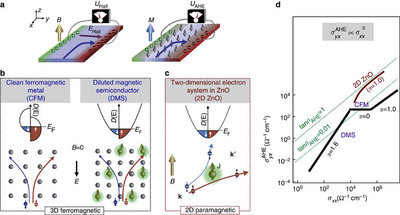Share this
D. Maryenko, A. S. Mishchenko, M. S. Bahramy, A. Ernst, J. Falson, Y. Kozuka, A. Tsukazaki, N. Nagaosa & M. Kawasaki
Abstract
Anomalous Hall effect, a manifestation of Hall effect occurring in systems without time-reversal symmetry, has been mostly observed in ferromagnetically ordered materials. However, its realization in high-mobility two-dimensional electron system remains elusive, as the incorporation of magnetic moments deteriorates the device performance compared to non-doped structure. Here we observe systematic emergence of anomalous Hall effect in various MgZnO/ZnO heterostructures that exhibit quantum Hall effect. At low temperatures, our nominally non-magnetic heterostructures display an anomalous Hall effect response similar to that of a clean ferromagnetic metal, while keeping a large anomalous Hall effect angle θAHE≈20°. Such a behaviour is consistent with Giovannini–Kondo model in which the anomalous Hall effect arises from the skew scattering of electrons by localized paramagnetic centres. Our study unveils a new aspect of many-body interactions in two-dimensional electron systems and shows how the anomalous Hall effect can emerge in a non-magnetic system.

Nature Communications: http://www.nature.com/articles/ncomms14777
These Related Stories